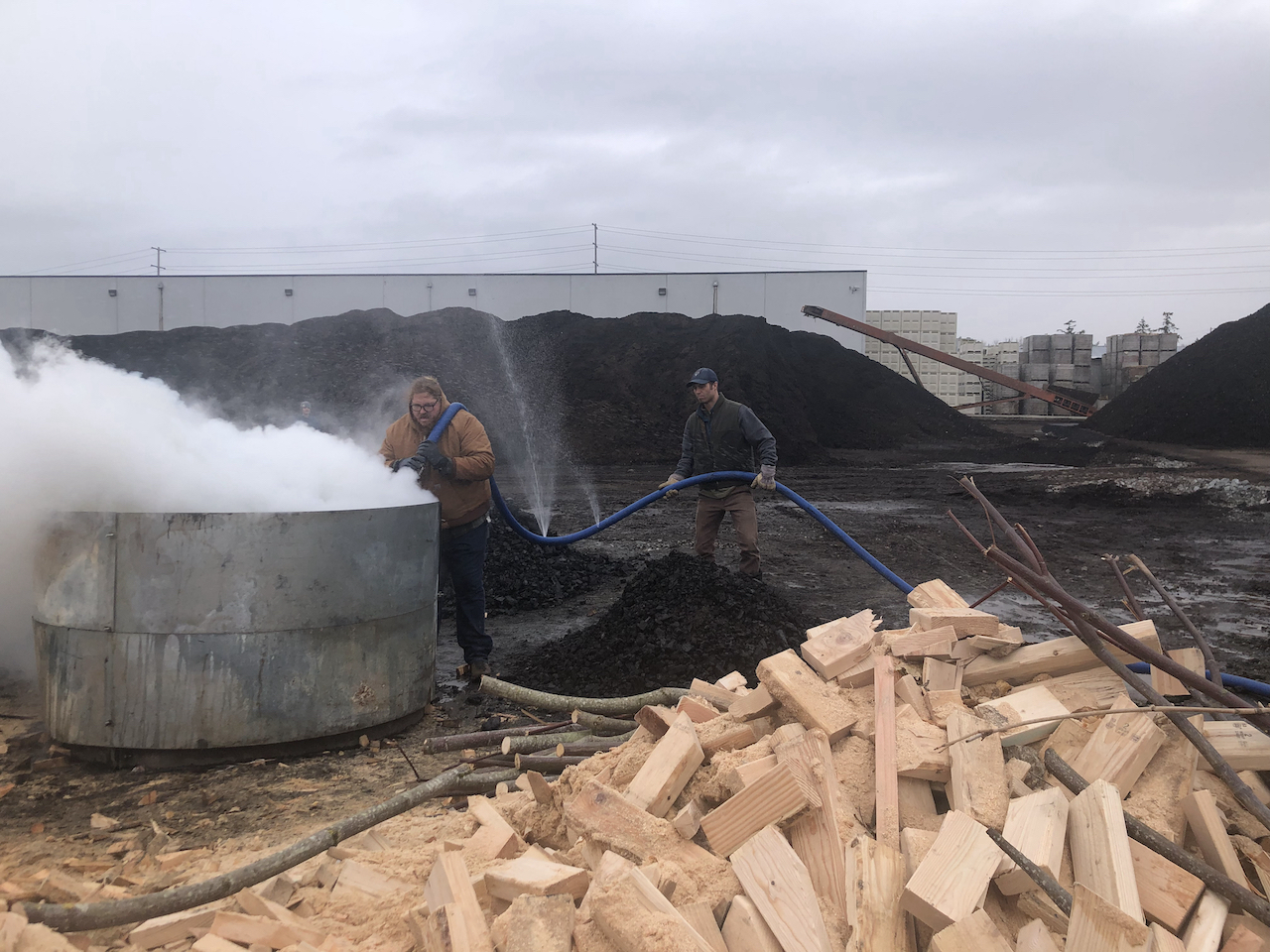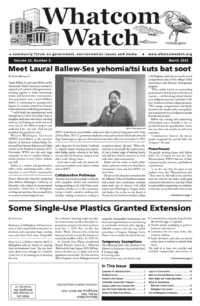Part 2
by Ava Stone

Steam billows from a ring-of-fire kiln as KCT partners quench the biochar with pressurized water.
photo: Gabe Travis
Introduction to the Project
Over the past year, the Kulshan Carbon Trust (KCT) has implemented a collaborative biochar pilot project involving 14 stakeholders in Whatcom, Skagit, and Island counties, Washington. We aimed to promote biochar as an important natural climate solution in our region and designed a pilot project to explore multiple production and application techniques relevant to our community. In the process, we diverted 207 tons of waste, sequestered an estimated 115 tons of carbon dioxide, developed an open-source carbon accounting methodology, and laid the groundwork for establishing a local biochar supply chain. We envision local biochar production and application fostering a marketplace that incentivizes sustainable land use practices, sequesters carbon, builds healthier soils, diverts biomass waste streams, and mitigates wildfire risk.
Biochar in Whatcom County
Around the world, indigenous communities have used biochar since time immemorial. It is not, however, well-known or widely produced in our region. As climate change impacts intensify, biochar is increasingly recognized as an emission-mitigation strategy for waste biomass management in forestry and agriculture operations. Most biochar is produced through a process called pyrolysis, or the partial combustion of organic material in an oxygen-limited environment. Pyrolyzing organic feedstock produces stable chars with high carbon content. These chars, known as biochar, are charcoal-like substances that can persist in soils for decades to millennia. (1) The stability of biochar keeps carbon dioxide out of the atmosphere, making it an important tool for mitigating climate change. Depending on the application type, biochar can be added directly to the soil, or amended with other nutrients to address a wide range of agricultural and environmental challenges. In some instances, biochar is used in non-soil applications such as biochar-amended concrete, building materials, and water filtration media.
The prevalence of forestry and agriculture positions Whatcom County to support a robust biochar economy. (2) Low-tech options such as kilns and conservation burns can be used to turn waste residue into biochar on-site. This eliminates the costs and emissions associated with outsourcing production to a centralized facility, and allows smaller scale producers to reduce their waste. Instead of burning slash piles or leaving waste to decompose, both releasing carbon back into the atmosphere, biochar offers an alternative that sequesters carbon and improves ecosystem health. By demonstrating the efficacy of low-tech biochar production techniques in our region, KCT hopes to improve access to biochar production for those historically excluded by high up-front costs and a lack of resources.
Biochar Production
To assess the potential of biochar in our region, our pilot project trialed three different methods for producing and applying biochar locally. The first used conservation burning techniques to turn forestry residue (i.e., slash piles) into biochar. These slash piles were machine built before the project began and would have been burned using conventional methods that sterilize the soil and incinerate the slash. By quenching the flames with pressurized water before the char burned to ash, we reduced soil disturbance and produced an estimated 9.8 tons of biochar from 17 slash piles. Once cooled and measured, the biochar was then spread directly onto the soil in-stand to return nutrients to the forest, suppress the growth of invasive species, and build soil health. We plan to use these findings to work collaboratively with local foresters to adapt slash-pile methods to better accommodate biochar production.
The second method used ring-of-fire kilns to turn clean construction waste previously destined for a landfill into biochar. The biochar was produced on site and mixed into an industrial composting process to create a value-added agricultural soil amendment. Agriculture feedstock was also incorporated into the process and pyrolyzed in the same kilns. The final co-composted product will be applied to a local farm field in spring, 2023, after which the impacts on soil health and plant growth will be measured. In total, this process occurred over two days and produced 1.7 tons of biochar.
The third method used conservation burns to combine a landscape scale fuel-reduction project with biochar production. This project is part of a larger restoration effort by the San Juan Island Conservation District to improve forest health through the burning of thousands of purpose-built conservation burn piles across multiple islands in the San Juans. Through this effort, we are exploring the potential of combining local fuel-reduction and fire mitigation work with biochar production in our region. Though still in progress, this project has sequestered an estimated 87 tons of carbon dioxide thus far.
Carbon Credit Valorization
To incentivize the uptake of biochar in our region, KCT is exploring different methods of payments, including allocating carbon credits to the stakeholders involved in a biochar project. With the implementation of Washington’s new Climate Commitment Act, the opportunity is ripe to ensure that credits awarded under the state program represent real carbon emissions reductions with meaningful co-benefits. To do so, we feel it is important these credits come from local projects with tangible impacts and robust measurement systems. Specifically, KCT is committed to ensuring the economic and environmental impacts of its projects benefit our community. To enable others to replicate our work, we will continually adapt our accounting methodologies to reflect best practices and ensure all project documentation is open-source and fully available to the public.
To garner diverse perspectives, KCT convened an advisory workgroup to help us shape a new credit class for carbon sequestered by low-tech biochar production. Composed of subject matter experts and practitioners, this workgroup considered issues of transparency, equity, and accounting to inform the creation of real credits with tangible benefits. By connecting local producers and consumers interested in biochar, the credits issued from KCT’s pilot project will be used to stimulate local climate action. Not only will projects be physically visible and transparent, local residents will be able to observe the genuine impacts of the projects. This built-in community monitoring lends legitimacy to carbon projects that we hope will excite support for a budding local carbon market. By providing an opportunity for small businesses and individuals in Whatcom County to purchase first-of-their-kind local credits, we intend to accelerate a local biochar economy based on transparency, durability, and trust.
Conclusion
As we reflect on the lessons learned from this initial project, we are excited to provide biochar education and technical assistance to our community, to offer small-scale land stewards access to local markets, and to continue developing a regional network to support the production and application of biochar locally. Our pilot demonstrated that biochar is an exciting natural climate solution for our region because it can be produced and applied using a variety of low-cost methods that are easily tailored to fit the diverse needs of our community.
To build on this momentum, we are currently focused on making biochar more accessible, feasible, and scalable in Whatcom County. To increase access, we are currently working to develop a kiln-loan program that will provide Whatcom County residents free access to the tools and training materials required to produce biochar. To improve feasibility, we intend to use our soon-to-be-published open-source carbon accounting methodology to issue valorized carbon credits to offset the costs of implementing these regenerative practices. Our first batch of credits will be based on the carbon sequestered in our initial pilot projects.
Lastly, to ensure long-lasting success and to continually scale biochar in our region, we are developing a carbon cooperative model to aggregate small-scale biochar projects and reduce barriers to entry. Using these techniques, KCT hopes to serve as a resource hub in Whatcom County to increase equity and transparency in the carbon marketplace and incentivize the uptake of natural climate solutions locally. Ultimately, we envision Whatcom County as a leader in using biochar and other regenerative land use practices to help mitigate climate change.
Please visit our website at kulshancarbontrust.org and look for one more article in Whatcom Watch. If you support our mission, please go to the Kulshan Carbon Trust website to find out how to get involved.
Endnotes
1. Rawat, J., Saxena, J., Sanwal, P., Rawat, J., Saxena, J., & Sanwal, P. (2019). “Biochar: A Sustainable Approach for Improving Plant Growth and Soil Properties.” In Biochar—An Imperative Amendment for Soil and the Environment. IntechOpen. https://doi.org/10.5772/intechopen.82151
2. Amonette, J. (2022). “Biomass to Biochar: Maximizing the Carbon Value” (No. 1). The Center for Sustaining Agriculture and Natural Resources
Next Month
An in-depth overview of local carbon markets and future directions of Kulshan Carbon Trust.
_______________________
Ava Stone is a graduate student at Western Washington University studying agroforestry and other land use practices that mitigate climate change. She has worked with the KCT as a graduate fellow since February 2022.




























